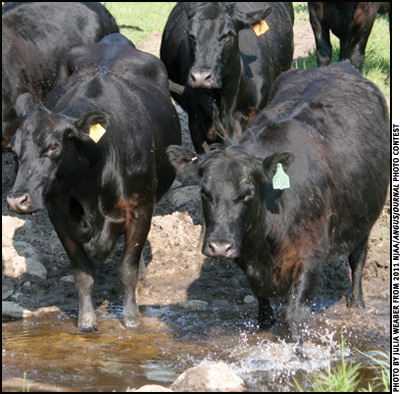 Summer Water
Summer Water
Providing a good water supply is a matter of quantity and quality.
A dependable supply of water is extremely important in summer. Cattle always drink more during hot weather. A 1,200-pound (lb.) dry cow might drink about 10.5 gallons (gal.) per day, and a lactating cow might drink up to 30 gallons per day, but both will drink more if weather is hot.
If water becomes contaminated by urine and feces — as when cattle have access to a pond — cattle may not drink as much, and it may put them at risk for disease. Some diseases, such as leptospirosis, can be spread by urine. Coccidiosis, E. coli, salmonella and a number of other diseases can be spread by feces.
Cattle often wade into water to try to cool themselves. When groups of cattle mill around in the water, they may trample and degrade the banks of the stream or pond — and muddy and contaminate the water. Cows often wade out as far as they can to get to cleaner water, but small calves generally drink from the bank or shallow areas. They won't drink much if water is dirty. Research trials have shown that calves drink more water (and have better growth) if they have a clean water supply vs. access to muddy, contaminated water.
This problem can be solved by fencing off the stream or pond. If you limit cattle to a controlled watering area or a trough where water is piped from the stream or pond, rather than letting them wade into the water source, they benefit from cleaner water and won't damage the riparian area by trampling the banks and eating all the vegetation. Rocks can be hauled in to protect the bank at the access area where cattle enter the water, so it won't become deep mud.
The most effective way to make sure cattle have clean water and can't damage or contaminate the pond is to fence it off and pipe water by gravity flow or pump to a water trough or tank. A float valve can regulate flow into the tank. Windmills have often been used for pumping water into a tank, and solar-powered pumps can work in some cases.

[Click here to go to the top of the page.]






